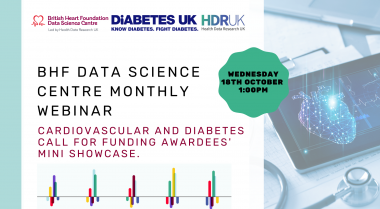Cardiovascular risk factors associated with venous thromboembolism
16 January 2019
John Gregson, Stephen Kaptoge, Thomas Bolton, Lisa Pennells, Peter Willeit, Stephen Burgess, Steven Bell, Michael Sweeting, Eric B. Rimm, Christopher Kabrhel, Bengt Zöller, Gerd Assmann, Vilmundur Gudnason, Aaron R. Folsom, Volker Arndt, Astrid Fletcher, Paul E. Norman, Børge G. Nordestgaard, Akihiko Kitamura, Bakhtawar K. Mahmoodi, Peter H. Whincup, Matthew Knuiman, Veikko Salomaa, Christa Meisinger, Wolfgang Koenig, Maryam Kavousi, Henry Völzke, Jackie A. Cooper, Toshiharu Ninomiya, Edoardo Casiglia, Beatriz Rodriguez, Yoav Ben-Shlomo, Jean-Pierre Després, Leon Simons, Elizabeth Barrett-Connor, Cecilia Björkelund, Marlene Notdurfter, Daan Kromhout, Jackie Price, Susan E. Sutherland, Johan Sundström, Jussi Kauhanen, John Gallacher, Joline W. J. Beulens, Rachel Dankner, Cyrus Cooper, Simona Giampaoli, Jason F. Deen, Agustín Gómez de la Cámara, Lewis H. Kuller, Annika Rosengren, Peter J. Svensson, Dorothea Nagel, Carlos J. Crespo, Hermann Brenner, Juan R. Albertorio-Diaz, Robert Atkins, Eric J. Brunner, Martin Shipley, Inger Njølstad, Deborah A. Lawlor, Yvonne T. van der Schouw, Randi Marie Selmer, Maurizio Trevisan, W. M. Monique Verschuren, Philip Greenland, Sylvia Wassertheil-Smoller, Gordon D. O. Lowe, Angela M. Wood, Adam S. Butterworth, Simon G. Thompson, John Danesh, Emanuele Di Angelantonio, Tom Meade, for the Emerging Risk Factors Collaboration
JAMA Cardiology (2019) 4(2):163-173
KEY POINTS
Question To what extent are established cardiovascular risk factors associated with risk of venous thromboembolism (VTE)?
Findings In this analysis of individual participant data from the Emerging Risk Factors Collaboration and the UK Biobank including 1.1 million participants, among a panel of several established cardiovascular risk factors, older age, smoking, and greater adiposity were consistently associated with higher VTE risk.
Meaning There is overlap in at least some of the major population determinants of important venous and arterial thrombotic diseases.
Importance It is uncertain to what extent established cardiovascular risk factors are associated with venous thromboembolism (VTE).
Objective To estimate the associations of major cardiovascular risk factors with VTE, ie, deep vein thrombosis and pulmonary embolism.
Design, Setting, and Participants This study included individual participant data mostly from essentially population-based cohort studies from the Emerging Risk Factors Collaboration (ERFC; 731 728 participants; 75 cohorts; years of baseline surveys, February 1960 to June 2008; latest date of follow-up, December 2015) and the UK Biobank (421 537 participants; years of baseline surveys, March 2006 to September 2010; latest date of follow-up, February 2016). Participants without cardiovascular disease at baseline were included. Data were analyzed from June 2017 to September 2018.
Exposures A panel of several established cardiovascular risk factors.
Main Outcomes and Measures Hazard ratios (HRs) per 1-SD higher usual risk factor levels (or presence/absence). Incident fatal outcomes in ERFC (VTE, 1041; coronary heart disease [CHD], 25 131) and incident fatal/nonfatal outcomes in UK Biobank (VTE, 2321; CHD, 3385). Hazard ratios were adjusted for age, sex, smoking status, diabetes, and body mass index (BMI).
Results Of the 731 728 participants from the ERFC, 403 396 (55.1%) were female, and the mean (SD) age at the time of the survey was 51.9 (9.0) years; of the 421 537 participants from the UK Biobank, 233 699 (55.4%) were female, and the mean (SD) age at the time of the survey was 56.4 (8.1) years. Risk factors for VTE included older age (ERFC: HR per decade, 2.67; 95% CI, 2.45-2.91; UK Biobank: HR, 1.81; 95% CI, 1.71-1.92), current smoking (ERFC: HR, 1.38; 95% CI, 1.20-1.58; UK Biobank: HR, 1.23; 95% CI, 1.08-1.40), and BMI (ERFC: HR per 1-SD higher BMI, 1.43; 95% CI, 1.35-1.50; UK Biobank: HR, 1.37; 95% CI, 1.32-1.41). For these factors, there were similar HRs for pulmonary embolism and deep vein thrombosis in UK Biobank (except adiposity was more strongly associated with pulmonary embolism) and similar HRs for unprovoked vs provoked VTE. Apart from adiposity, these risk factors were less strongly associated with VTE than CHD. There were inconsistent associations of VTEs with diabetes and blood pressure across ERFC and UK Biobank, and there was limited ability to study lipid and inflammation markers.
Conclusions and Relevance Older age, smoking, and adiposity were consistently associated with higher VTE risk.



